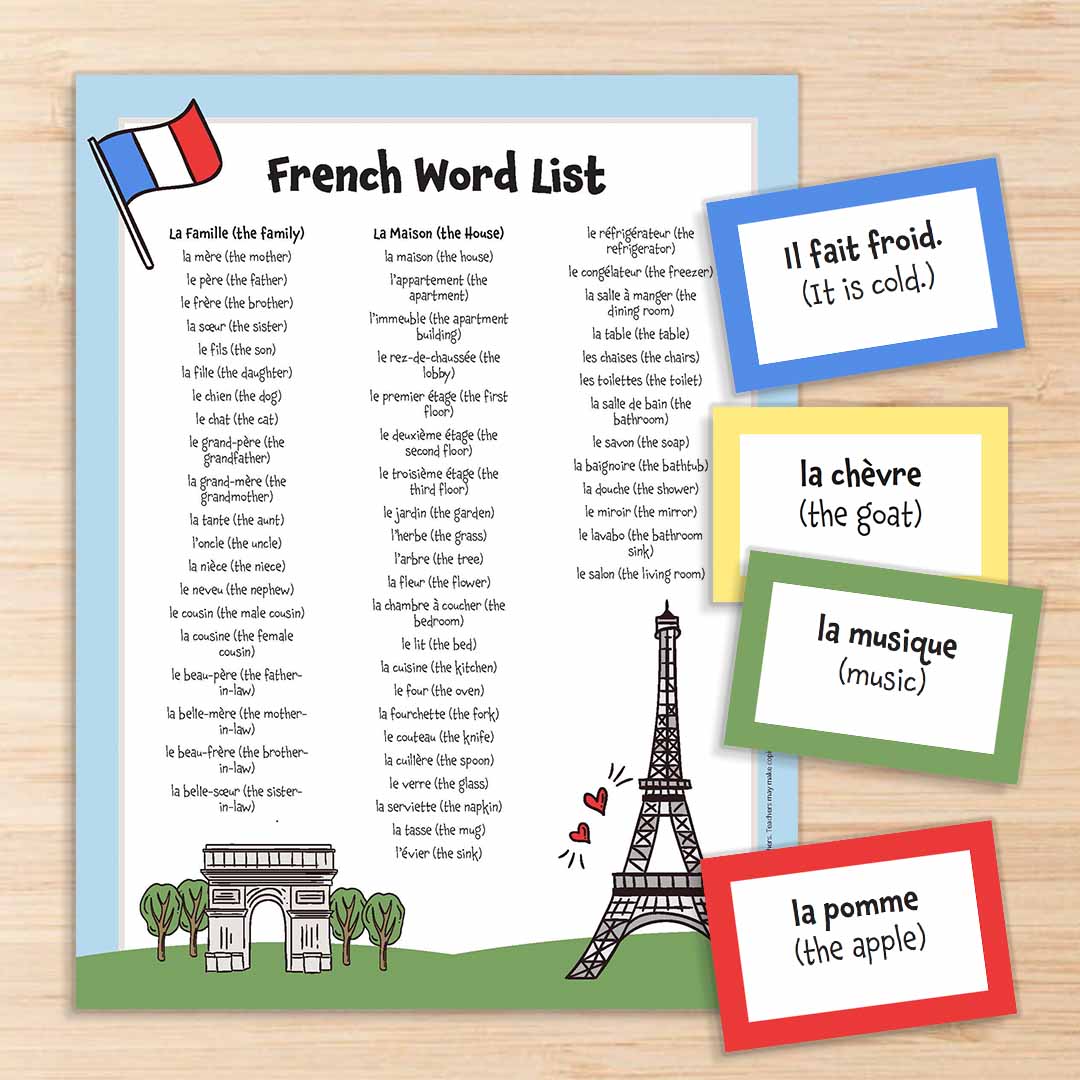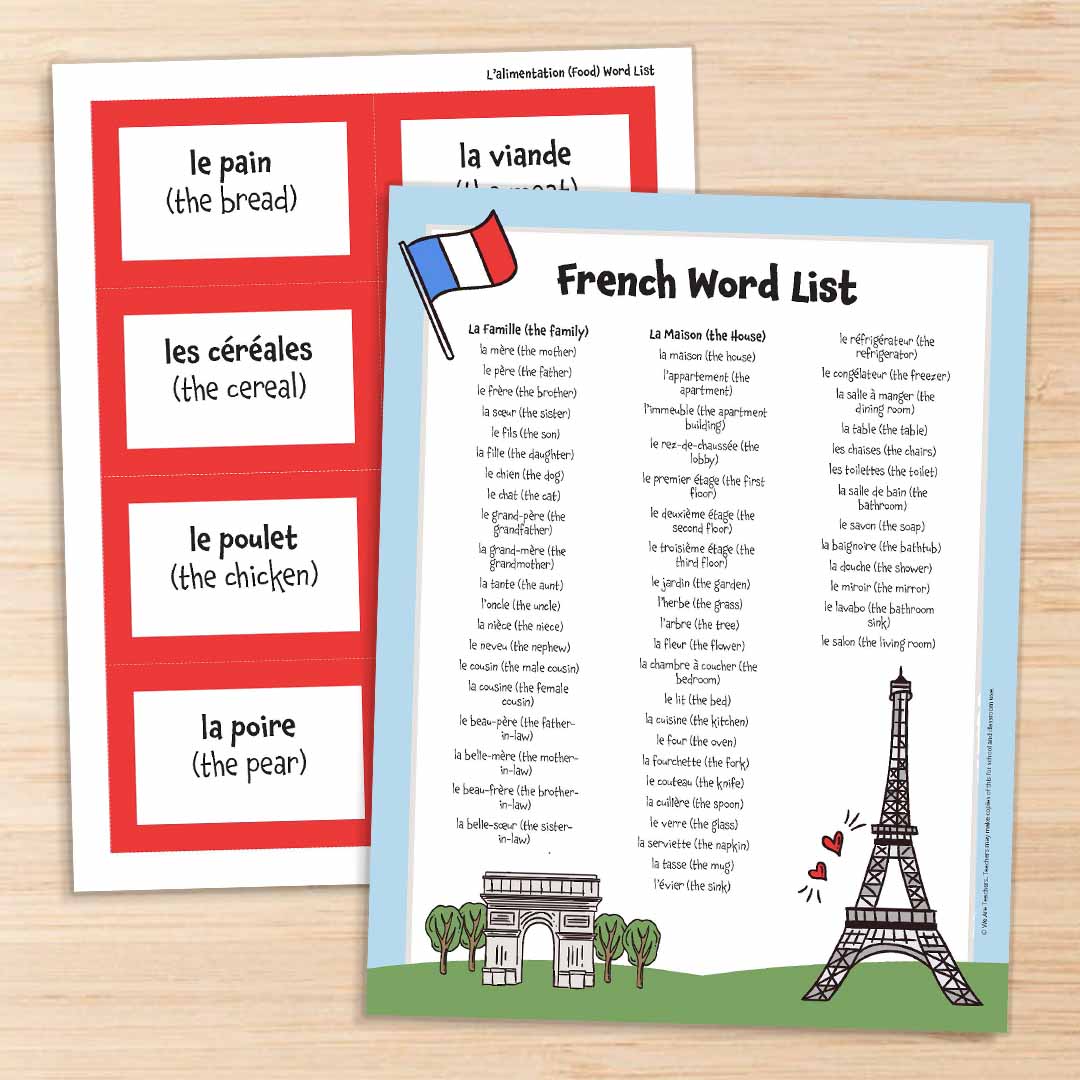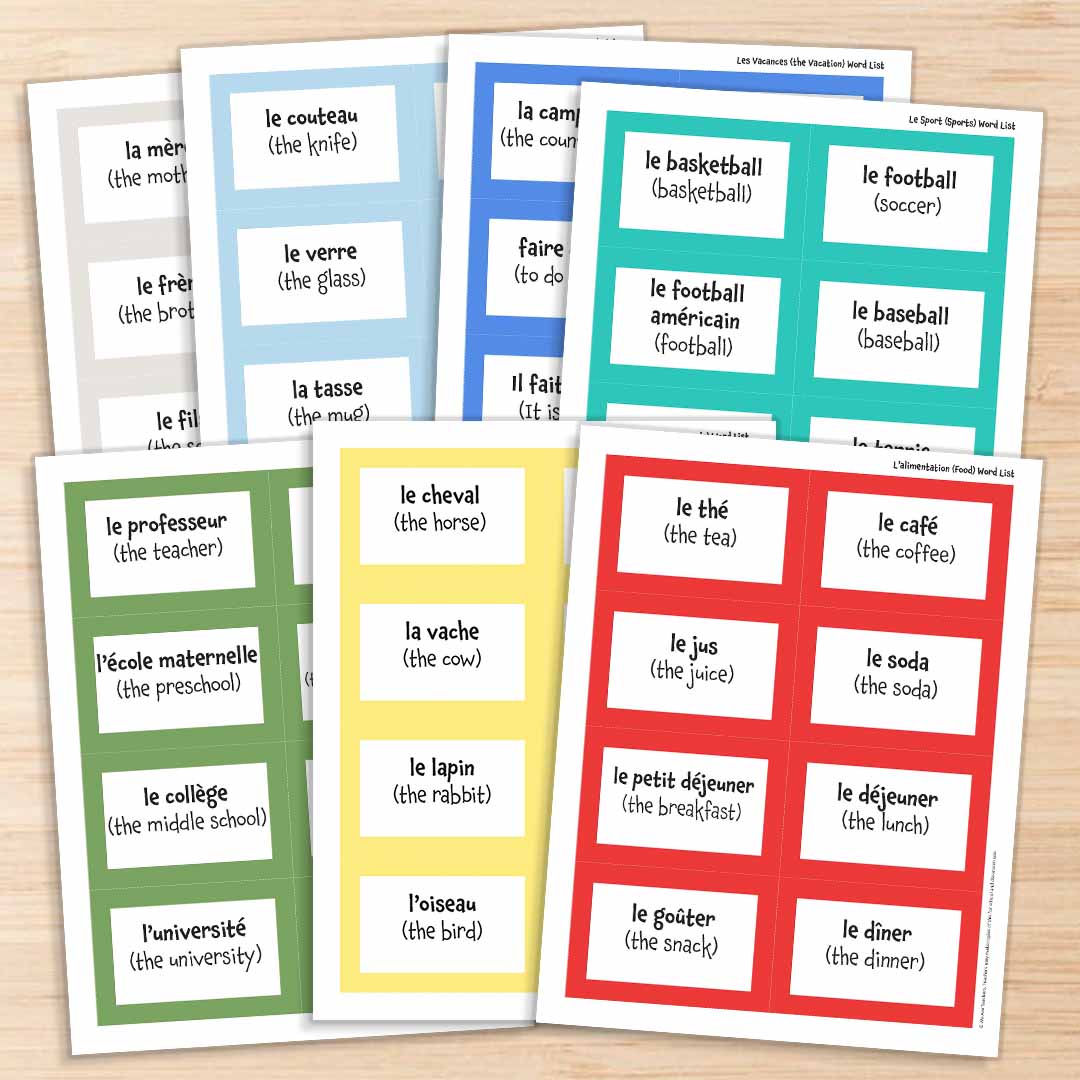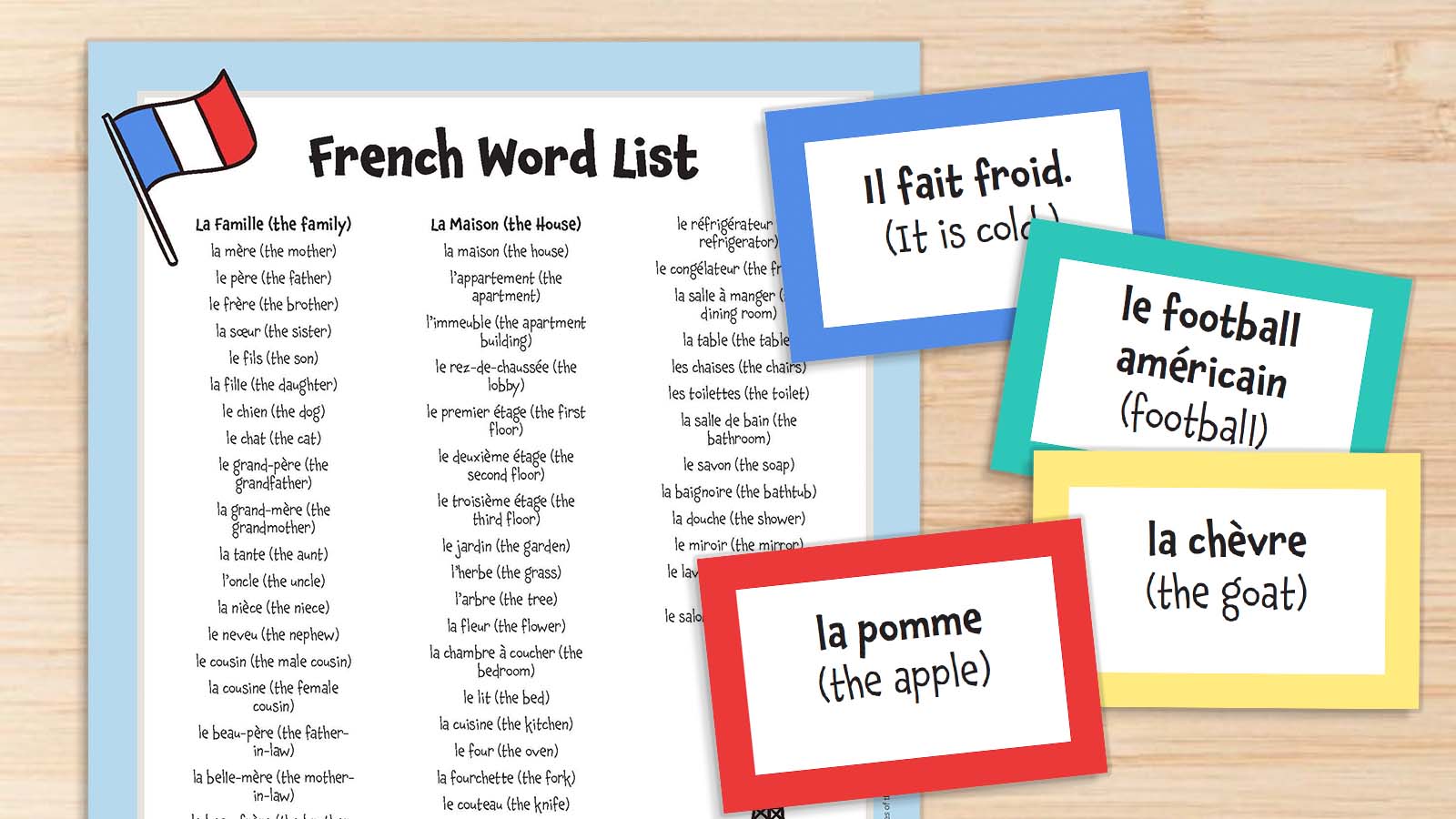Looking to refresh how you teach French vocabulary to your students? Check out our French vocabulary lists for family, house, vacation, sports, school, animals, and food. Then try some of the fun activities below to rejuvenate your lesson plans!
Plus, grab our free printable French vocabulary lists and cards. Just fill out the form on this page for instant access.
French Vocabulary Lists

La Famille (the Family)
la mère (the mother)
le père (the father)
le frère (the brother)
la sœur (the sister)
le fils (the son)
la fille (the daughter)
le chien (the dog)
le chat (the cat)
le grand-père (the grandfather)
la grand-mère (the grandmother)
la tante (the aunt)
l’oncle (the uncle)
la nièce (the niece)
le neveu (the nephew)
le cousin (the male cousin)
la cousine (the female cousin)
le beau-père (the father-in-law)
la belle-mère (the mother-in-law)
le beau-frère (the brother-in-law)
la belle-sœur (the sister-in-law)
La Maison (the House)
la maison (the house)
l’appartement (the apartment)
l’immeuble (the apartment building)
le rez-de-chaussée (the lobby)
le premier étage (the first floor)
le deuxième étage (the second floor)
le troisième étage (the third floor)
le jardin (the garden)
l’herbe (the grass)
l’arbre (the tree)
la fleur (the flower)
la chambre à coucher (the bedroom)
le lit (the bed)
la cuisine (the kitchen)
le four (the oven)
la fourchette (the fork)
le couteau (the knife)
la cuillère (the spoon)
le verre (the glass)
la serviette (the napkin)
la tasse (the mug)
l’évier (the sink)
le réfrigérateur (the refrigerator)
le congélateur (the freezer)
la salle à manger (the dining room)
la table (the table)
les chaises (the chairs)
les toilettes (the toilet)
la salle de bain (the bathroom)
le savon (the soap)
la baignoire (the bathtub)
la douche (the shower)
le miroir (the mirror)
le lavabo (the bathroom sink)
le salon (the living room)
le canapé (the couch)
la télévision (the television)
le garage (the garage)
le grenier (the attic)
le sous-sol (the basement)
Les Vacances (the Vacation)
l’avion (the plane)
le train (the train)
le métro (the subway)
la voiture (the car)
le billet (the ticket)
la valise (the suitcase)
l’aéroport (the airport)
la gare (the train station)
la plage (the beach)
l’océan (the ocean)
la piscine (the pool)
le sable (the sand)
le maillot de bain (the bathing suit)
des lunettes de soleil (the sunglasses)
la crème solaire (the sunscreen)
Il fait chaud. (It is hot.)
la campagne (the countryside)
les montagnes (the mountains)
faire du ski (to do skiing)
la neige (the snow)
Il fait froid. (It is cold.)
les gants (the gloves)
le bonnet (the hat)
l’écharpe (the scarf)
la colonie de vacances (the summer camp)
Le Sport (Sports)
le basketball (basketball)
le football (soccer)
le football américain (football)
le baseball (baseball)
la randonnée (hiking)
le tennis (tennis)
la natation (swimming)
le golf (golf)
la gymnastique (gymnastics)
le stade (the stadium)
le match (the match)
les Jeux Olympiques (the Olympic Games)
L’école (the School)
le professeur (the teacher)
la garderie (the daycare)
l’école maternelle (the preschool)
l’école élémentaire (the elementary school)
le collège (the middle school)
le lycée (the high school)
l’université (the university)
le crayon (the pencil)
le stylo (the pen)
les feutres (the felt pens)
les marqueurs (the markers)
les ciseaux (the scissors)
les livres (the books)
le papier (the paper)
le cahier (the notebook)
le classeur (the binder)
le tableau noir (the blackboard)
la gomme (the eraser)
la trousse (the pencil case)
le cartable (the school bag)
le sac à dos (the backpack)
les mathématiques (math)
les sciences (science)
l’histoire-géographie (social studies, history, geography)
les arts plastiques (art)
la musique (music)
la technologie (technology)
Les Animaux (the Animals)
le cheval (the horse)
la chèvre (the goat)
la vache (the cow)
la poulet (the chicken)
le lapin (the rabbit)
le hibou (the owl)
l’oiseau (the bird)
le poisson (the fish)
le lion (the lion)
le zèbre (the zebra)
le perroquet (the parrot)
l’araignée (the spider)
le tigre (the tiger)
le singe (the monkey)
le serpent (the snake)
L’alimentation (Food)

le pain (the bread)
la viande (the meat)
les céréales (the cereal)
le sandwich (the sandwich)
le poulet (the chicken)
la pomme (the apple)
la poire (the pear)
l’orange (the orange)
la tomate (the tomato)
le concombre (the cucumber)
la salade (the salad)
le chocolat (the chocolate)
la glace (the ice cream)
le croissant (the croissant)
le pain au chocolat (the chocolate croissant)
le lait (the milk)
le thé (the tea)
le café (the coffee)
le jus (the juice)
le soda (the soda)
le petit déjeuner (the breakfast)
le déjeuner (the lunch)
le goûter (the snack)
le dîner (the dinner)
le restaurant (the restaurant)
Activities To Teach French Vocabulary
Introduce the Words
To introduce the words initially in context, tell your students a simple story that uses the target vocabulary. Keep the story understandable by including plenty of cognates and high-frequency words, drawing pictures, and using repetition and gestures. Afterward, ask your students four easy true-or-false questions in French about the vocabulary to gauge their understanding (example: If the target word is “mother,” you could ask, “Is the mother named Pierre or Anne?” depending on your story’s details).
Next, give your students printed copies of the story with the target vocabulary in bold with an image that represents that word’s meaning (check out thenounproject.com for tons of free icons). Then, give out a list of simplified definitions in French that students then try to match with each vocabulary word. Keep the definitions based on cognates or other high-frequency words they will be familiar with. Finally, review the answers. Were they able to match the definitions to the words based on context clues from the story and the provided definition?
Another way to introduce vocabulary is to create “this or that?” slides. For a unit that includes school-related vocabulary, for example, display a slide that provides labeled pictures of a pen and a pencil. Then students share which they prefer writing with (counting the totals is a great way to sneak in number review as well!). Give students a printout of the slideshow before beginning so they have access to all the vocabulary you’ll be teaching.
Gamify
Create a free review game on a site like Blooket.com. Each question would provide the definition in French, and students pick the right word to match it in English. They will love playing a video game to practice their vocabulary!
Vocab Bee
Students stand in two lines in front of you so that you are facing two students at a time. Hold up a card that provides the French definition for them to read, while on the back of the card only you can see the vocabulary word. The student who says the correct vocabulary word first wins the round. Then those two students go to the back of the line, and the process repeats with the next two students you’re now facing.
Associations
One student pulls a vocabulary word out of a hat. They have to get the rest of the class to name the word by saying related descriptions or associated words in French. For example, if the term is “the beach,” they might say “summer,” “sand,” and/or “ocean,” or give the name of an actual beach as an example. Another way to do this activity is to give students a list of places, and the class has to use the French vocabulary to figure out the place. For example, if they’re working on a travel unit, and the class has to guess Disney World, they might ask about weather, what clothes to bring, transportation to get there (plane? car? train?), domestic or international, and so on.
Who Am I?
Pass out whiteboards to students. Read off three clues in first person (e.g., for scissors, you might say, “You can cut paper with me. I love art class. I’m sharp.”). Keep the clues a mix of easy and more challenging. Students write the vocabulary word on the board and hold it up for you to say if they got it right. After you’ve done this activity a few times, elevate the challenge by giving students cards with one vocabulary word written on it and having them take turns giving clues to the class.
Crayon Battle
Students compete in pairs for this game. Each person has a different-colored crayon. Give each pair one sheet of paper with the vocabulary words printed randomly all over the page. Then, read out loud the definition or associations in French. The first person in the pair to circle the word on the paper gets a point for that round. At the end of the game, students count up how many points they have to determine a winner.
Student Storytelling
Using your introductory story as a model, students write their own simple stories featuring the target vocabulary, then present them to the class. After reading, the presenting student asks the class four questions in French about their story; they could be true-or-false or open-ended. This is a creative and interactive way to conclude any unit.
Get your free French Vocabulary Printables now!

Just click the link below and you’ll get access to our word list.

